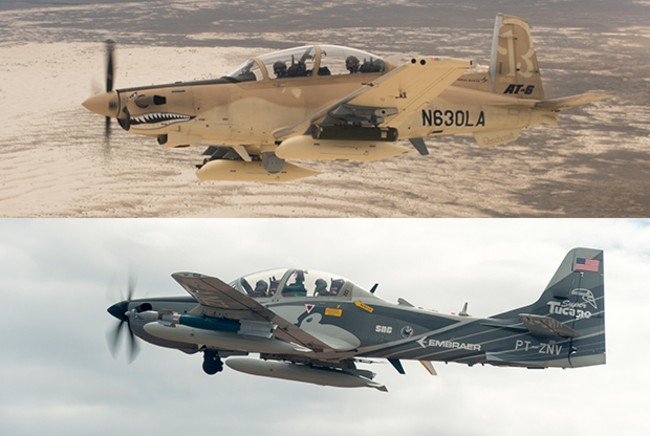
USAF plans to purchase two to three of both the Textron AT-6B Wolverine (shown at top) and the Sierra Nevada-Embraer A-29 Super Tucano to continue work on the light-attack aircraft effort. Air Force photos.
The Air Force plans to buy a small number of AT-6 and A-29 aircraft, to be split between Air Combat Command and Air Force Special Operations Command, as its light-attack experiment shifts into an acquisition program.
The service on Oct. 24 released its final request for proposals, which states it plans to purchase two to three light-attack aircraft each from Textron Aviation, which produces the AT-6, and the Sierra Nevada Corp.-Embraer team that offers the A-29. The Air Force expects to issue a contract for the A-29 by end of the year, and for the AT-6 in early 2020.
The AT-6 will go to Nellis AFB, Nev., where ACC will use it for testing and development of “operational tactics and standards for exportable, tactical networks that improve interoperability with international partners,” the Air Force said in an Oct. 24 release.
Meanwhile, the A-29 will go to Hurlburt Field, Fla., where AFSOC will use it to create an instructor pilot program for those who advise foreign nations on air warfare. The program will help meet “increased partner nation requests for light-attack assistance,” according to the Air Force.
The light-attack experiment began in August 2017, when USAF and Navy pilots flew a range of aircraft at Holloman AFB, N.M., to evaluate their ability to perform close air support and related missions in permissive areas. Air Tractor and L3 Technology’s AT-802 Longsword and Textron’s Scorpion also participated in the experiment, but was not selected to move forward in the process. Air Tractor later filed a protest related to the light-attack program with the Government Accountability Office, which was quickly dismissed.
“Our focus is on how a light-attack aircraft can help our allies and partners as they confront violent extremism and conduct operations within their borders,” Air Force Chief of Staff Gen. David Goldfein said in the release. “Continuing this experiment, using the authorities Congress has provided, gives us the opportunity to put a small number of aircraft through the paces and work with partner nations on ways in which smaller, affordable aircraft like these can support their air forces.”
The turboprop planes will also be used to “examine a common architecture and intelligence-sharing network” that bridges them with sensors and other platforms, according to the release.
“If I hear one thing from my international air chiefs, it’s, ‘We need to figure out how to share information both ways,” Goldfein said.